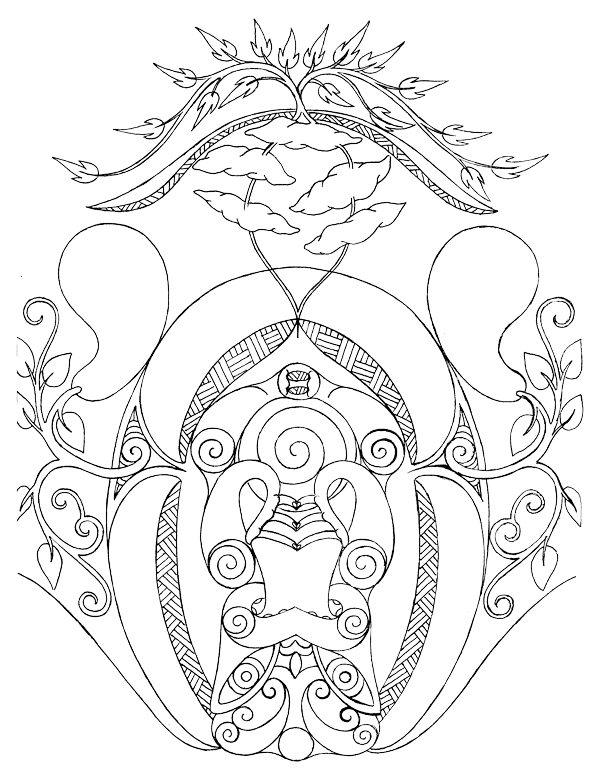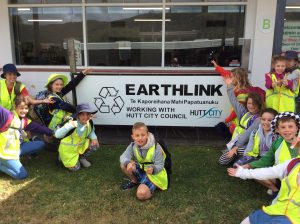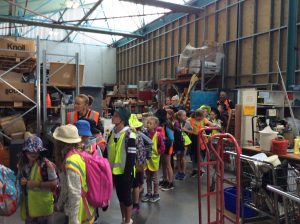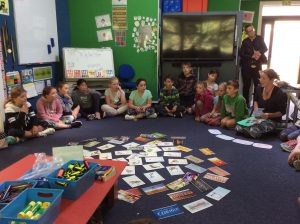
Rongomatāne: Qualities of peacefulness and order, provision, cultivation.
When thirty-one Year 5 and 6 students from Normandale School spent a day out in Lower Hutt on a Enviroschools/Hutt City Council World Of Waste tour, they were amazed by the affect the waste in a landfill has on our environment, and inspired by how creativity can reduce that impact.
At the start of their tour on Thursday 28th February 2019, the Normandale School students thought about a space where they love to spend time and an atua related to that place. Throughout the tour they kept that space in mind and focused on how we can protect the spaces that are important to them.

The first stop of the tour was the Silverstream Landfill where students realised that there is no such place as “away” when it comes to rubbish. While the landfill might be the best solution we have right now, much of what we put underground never biodegrades. They learned that 35% of landfill is currently made up of food waste.
This would be much better transformed into compost because when food rots in an environment without oxygen it releases harmful gases. They understood why the worm farms they have back at school for breaking down their food scraps are so important. The Normandale School worm farms have been going for eight years, since their teachers first did the World of Waste tour!
“I learnt people fitted a lot of rubbish underground and this probably shouldn’t happen because of the impact on environment.”
“I was amazed at how a landfill affects the environment, so much toxic air.”
Visits to the places at the landfill from where Earthlink collects furniture and whiteware, and Macaulay’s Metals collect car batteries, showed that not all unused items need to end up in the landfill.

The next stop on the tour was the Earthlink workshop where students saw how staff repurpose items or remove the metal components to sell on.
Students were impressed and motivated by the innovative and clever alternatives the staff were finding for unwanted items.
“Now I am going to recycle things and give them a second life – maybe give things to somebody else”.
 At the third stop, the Dowse Art Museum, the focus was the impact fabrics have on the environment and how using natural materials for clothing or storing kai benefits the environment since they will eventually biodegrade.
At the third stop, the Dowse Art Museum, the focus was the impact fabrics have on the environment and how using natural materials for clothing or storing kai benefits the environment since they will eventually biodegrade.
Students had the opportunity to begin the process of creating fabric by harvesting harakeke. They learned the tikanga around this process and scraped the surfaces off the harakeke leaves to reveal the muka which can be used in fabric.
After lunch and a stretch of their legs, students saw what happened to their curbside recycling at Waste Management’s Recycling Centre – 1 and 2 plastic is bailed for Flight Plastic to turn into packaging and the paper and cardboard is bailed and sent for recycling. “I learnt how many things could be recycled that people were chucking out without a second thought.”
 Finishing the day back in the classroom with a ‘Head, Heart and Hand’ round, the students shared what they had learnt, what they felt, and actions they intend to take now as a result of their new learning. The teachers’ plan included using the student insights to further their in-class enquiry.
Finishing the day back in the classroom with a ‘Head, Heart and Hand’ round, the students shared what they had learnt, what they felt, and actions they intend to take now as a result of their new learning. The teachers’ plan included using the student insights to further their in-class enquiry.
“I was amazed at how much rubbish was in one truck.”
“I learnt how many cubes are created with our recycling.”
“I was curious about how machines worked and how everything can be recycled again and again.”
